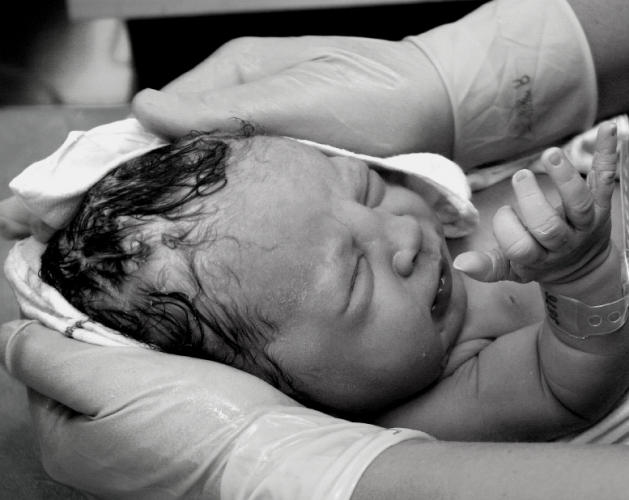
Joanne Motino Bailey
Most nurse-midwives go through nursing school first, then work in labor and delivery units. Then they say to themselves, "There really must be a better, more woman-family-centered way to provide care." And they go back to school to get a masters degree in nurse midwifery.
Not Joanne Motino Bailey, C.N.M. The 43-year-old director of U-M's Nurse Midwifery Service took the road not taken, and that made all the difference.
A Strong Calling
Originally from Midland, Michigan, Joanne received her U-M undergraduate degree in Japanese language and literature, with the intention of going on to medical school. "I felt like I had a strong calling to work in health and healing," she says.
And while she already spoke an impressive number of languages - Japanese, German, French-she felt she needed to learn Spanish. "So after graduating from college, I hired a tutor, learned Spanish, and joined a British hospice organization in Honduras, Central America, working as a health care volunteer."
For three and a half years, while still in her early twenties, Joanne worked with women and children infected with HIV and AIDS.
"There wasn't much saving," she recalls. "There was a lot of comforting. (At that point) I didn't have a nursing background, but I worked with these British nurses. I learned a lot about basic nursing.
A Common Ground in Comforting
"There are many similarities between midwifery and hospice care," she says. "So much of it is walking with people through sometimes joyous and sometimes tragic situations. There are a lot of things we can't fix, but there is a lot of comfort to be provided.
"Being able to sit with and be with people during those intense moments and be real and connected is a huge service in the world."
When Joanne returned to Ann Arbor, she chose not to go to medical school, and instead, pursued a career in advanced practice nursing, specifically nurse midwifery. "That just jumped out and called to me," she says. "I did the whole thing, second career in nursing all the way to Ph.D., in six years. It was really fast," she says.
What came slowly was the acceptance of a midwifery team of female nurses delivering babies in the hospital.
By 1940, almost all births in the U.S. were happening in hospitals, and attended by male physicians. The whole process of giving birth, says Joanne, became "very medicalized."
In the late 1960s, with the women's movement, there was a move away from the medical model. "Women had access to reproductive health care, birth control, etc. There became a real cry for 'do all babies need to be born with forceps?' 'Do they have to be given drugs during labor?' 'Are these things all necessary for having a healthy baby?'" The answer was a resounding NO.
Integrating Prenatal Care and Childbirth
The Nurse Midwifery Service at UMHS was born in the 1980s. It offered women an integrated approach to medical care, with particular emphasis on prenatal care and childbirth.
The word "midwife," Joanne says, means "with woman. We believe that normal birth is a natural life process," says Joanne. "It doesn't mean it's easy, but that it is a natural life process, and in circumstances where everything is going well, should be left unencumbered or un-interfered with, though closely monitored and watched."
The midwife is the caregiver from day one of the pregnancy. "The idea is, we talk about nutrition and childbirth preparation, and education, and what's your support and how are you planning for the baby."
U-M midwives work "almost everywhere," Joanne says: in the two Washtenaw County Planned Parenthoods, five (of the eight) U-M clinics (Von Voigtlander Women's Hospital, East Ann Arbor, West Ann Arbor, Brighton, Canton), and were one of the first teams to voluntarily staff the Corner Health Center, a pregnant teen clinic in Ypsilanti. The Midwifery Service includes eight nurse midwives, who each have regular clinics and share "call" at the hospital.
In addition to Directing the Midwifery program and, as Joanne puts it, "catching babies," Joanne teaches a 400-person class each academic year called "Perspectives in Women's Health" in the Women's Studies department.
Teaching Others How to be Present
"Lately my goal is teaching as many midwives as possible, and teaching midwifery skills to physicians who are going into care-providing for pregnant women."
When asked, "What makes a good midwife," Joanne says, "I feel like really the biggest thing is being truly present with people. Obviously you have to like birth and you have to like pregnant moms and children."
While she notes that more men are going into nursing careers, she adds, "midwifery is still a very protected space."
"I often label midwives in sort of different ways. You can midwife someone through a death. You can midwife someone through their cardiac surgery. It's not only physically being present but it's being wholly present-heart centered-committed to making this the best experience possible, regardless of the context of what's going on."
"It's caring for the body and caring for the spirit at the same time."